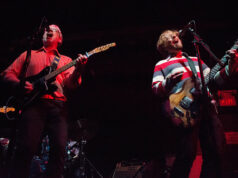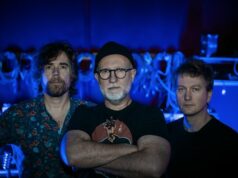
Rick Allen of Def Leppard behind his famous drum kit. (Photos courtesy Mad Ink PR)
This weekend, Rock and Roll Hall of Famer and legendary drummer of Def Leppard Rick Allen will make two special appearances in the Washington, DC area to display his art work in two separate exhibitions. First, on Saturday, Oct. 23 in the Wentworth Gallery at Tysons Galleria, in McLean, Virginia, and again on Sunday, Oct. 24 in the Wentworth Gallery in the Montgomery Mall in Bethesda, Maryland, fans and art collectors alike will be able to browse Rick Allen’s artwork, including “Wings Of Hope 2021,” one of his newest pieces.
Best known for being the drummer on major hits such as “Pour Some Sugar On Me,” “Photograph,” “Hysteria,” and “Rock Of Ages,” the British drummer will have art of an entirely different genre on display. His new and extraordinary collection houses originals, limited editions, the painted drum series, mixed media originals, plus the Legends Series, featuring new portraits of Eddie Van Halen, Kurt Cobain and Johnny Cash.
Rick Allen took time out of his schedule to speak with Parklife DC’s Chris Smyth in advance of his shows. In an enjoyable discussion, Rick explained the variety in his artwork, a piece that he is currently working on, the influence and inspiration his youngest daughter had on his work, and how a trip to Walter Reed Army Medical Center influenced his charitable endeavors.
(This discussion has been edited for length and clarity.)
Chris Smyth: How long have you been interested in creating your own artwork? Has it been a lifelong passion or is it something you picked up recently?
Rick Allen: It’s actually a long journey. I really got into painting when I was a kid, just for the fun of it. I’d get paint on the ceiling and the floor and everywhere. I loved the whole idea, but I never really thought much about it.
My grandpa got me my first camera and I got really into photography. And then, of course, around the age of 9 or 10 I started getting into music, and that took center stage for quite a while. When my youngest daughter was born we started painting together and it reminded me of when I was a kid, and it reignited my passion for painting.
I had a decent back catalogue of pieces that I really liked but I was always afraid to show them. I was afraid that people would be judgmental, “oh a rock star trying to be an artist.” But my wife was like “These are great, you should show them.” So I started working with a company called Scene Four and that was really cool to get my feet wet. And then I met up with Wentworth Gallery, Christian O’Mahony, and that’s when I really started getting into it. With direction from him, and ideas from myself and my wife we ended up coming up with themes that took in my life growing up in England, coming to America in 1980 and adopting some of my life experience being here in America.
Watch a video preview of Rick Allen’s upcoming exhibition at Wentworth Gallery on YouTube:
https://youtu.be/w6hv_GXX0VM
CS: What is your medium? Is it mixed media or is it all painting?
RA: When I’m painting the Legends pieces or the flags or when I do some of the abstract pieces, that’s all done from scratch, and that’s all done using acrylic paint on canvas. Then what I started doing was taking high resolution photographs of the original and then taking those pieces and enhancing prints. So instead of there being a single, original piece, it meant that I could create pieces with better price points so that everybody could actually buy a piece if they wanted to.
One of the things that I realized was that the painting really took me to the same place that I go when I play music — being in the moment. And now I find that it’s really quite therapeutic, particularly for my PTSD from extreme trauma.
CS: You touched on it a bit, but is there any crossover between painting and drumming?
RA: I think so. I’ve started to adopt the whole idea that creativity is interchangeable. If you’re interested in photography, or painting, or dance, or music, or any kind of artistic endeavors, I feel as though just being in that creative place really does keep us in the moment. Sometimes I can go in the art room for hours at a time and not even know it, simply because I’m fully invested in the piece that I’m working on.
I think that one of the things I learned from painting with my daughter was that she started to paint without any rules. And I’d ask her, “Don’t you want to use a different color there?” And I was listening to myself and was like, “No, what are you talking about?” And she’d be like “No, Daddy. It’s finished.” And I found that to be very freeing. It’s very liberating to be able to paint without any rules. And my hope is that if I like it, then there will be other people out there who like it too.
As soon as I’ve come up with something concret like a flag that everybody recognizes, then I can put anything I’d like over the top of it and create a different mood for a flag. I try not to get too bogged down in the technical side of things.

Rick Allen with two of his painted drums
CS: Obviously you’re British, but the Union Jack has been a prominent display of yours and your band both on the stage and now here in your artwork, as well as the American flag. What is it about the imagery of those flags that makes you want to feature them so prominently?
RA: I think the whole British invasion thing which has been going on forever. I’m not sure who stole the idea from the Monarchy, but if you’ve ever seen any of the imagery of The Who or The Beatles or The Stones, somewhere along the line they featured this Union Jack. Def Leppard weren’t the first to have done it, we just borrowed the idea from all the generations of rock music that came before us.
In a similar way, it wasn’t until I got to America in 1980, and then I settled in America in 1991, I believe, then I started to create memories and experiences based on my time here in America. Over the years I realized that America has given me a lot of opportunities and a lot of freedom for me to be who I want to be, and express myself in so many different ways. It’s such a blessing.
CS: I want to talk about the Legend pieces. I believe you have three new ones, Eddie Van Halen, Johnny Cash, and Kurt Cobain. And what stands out to me on these is that most of your artwork is very colorful, whereas these Legends pieces are black and white with a little bit of color mixed in. In Eddie’s guitar you just see the red. In Kurt Cobain’s eye you just see a little hint of blue. Why did you decide to go so differently color wise than from the rest of your artwork?
RA: That’s a good question. I guess I wanted to keep a slightly darker theme. These are incredible people, musicians, artists that have inspired me over the years, but they’re not here anymore, they’re deceased. But that doesn’t mean that I can’t lift them up on a pedestal. But I wanted to keep that sort of mystic about them, and I think creating black and white pieces was a good way to do that.
Every time that I look to Kurt Cobain I was always drawn to his eyes because they were so striking. That blue! If I do something in black and white then I can create the focal point that I want people to be drawn to, and I think the Kurt Cobain piece is a classic example of that.

Rick Allen and his piece honoring Johnny Cash
CS: I’m sure you’ve had hundreds, thousands of inspirations throughout your lifetime. How did you settle on the people that you wanted to honor in this way?
RA: Again, it’s a great question. It seems like over the last, I don’t know how many years, we keep losing more and more and more incredible people. The one you didn’t mention, and for good reason, I haven’t put it out on social media, but I did a really cool piece of Charlie Watt.
CS: So that has to be brand new.
RA: It is. In fact there are a couple of finishing touches on it I want to make, so unfortunately it won’t be available for these upcoming shows. There is never a shortage of people who inspire me. I did John Lennon but I didn’t do George Harrison. Aretha Franklin, she’s another one. Just a complete powerhouse and probably one of the best voices and most recognizable voices on the planet. So there’s a lot more I can get to, it’s just having the time to do it.
CS: I want to hit on one more series of yours. One series that stands out to me because it seems so different from the rest of your work is the little girl on the swing series. It has this innocence, and depending on the background it has a bit of wonder, but it seems so disparate from everything else that I can find. What is it with that imagery that makes you want to put that out there?
RA: It all relates back to my daughter. The first one that I did my daughter must have been about 4 or 5. It’s my daughter that on the swing. We used to go to this place as a family and they had this really cool swing hanging from this oak tree, and whenever she was on this swing she was just in a place of fantasy. And I thought this was a great opportunity. I can take that beautiful feeling of innocence and being in a fantasy place and I can create different backgrounds and conjure up that wonderful place that we all were as kids before it all got serious. And I’d like to keep her in that place for as long as possible. So I did a series of them and I wasn’t sure how they would be received at first, but people really loved them. And they say “I look at this piece and it reminds me of my own kids.” And that’s exactly what I wanted. I wanted people to feel what it was like to be a kid again. And I’m glad you picked up on that, just being in that place of fantasy.
CS: With all of your artwork that is going to be on sale this weekend, there is a charitable aspect to it. Proceeds from each sale will go to Project Resiliency. Could you explain what that is and why that’s important to you?
RA: Back in 2001, my wife and I set up Raven Drum Foundation based on my experience of extreme trauma, and her experience of being in the healing arts. When I met her she was working at the Boulder College of Massage and was really good at what she did. She helped me on many occasions. That was the beginning of it. Then in 2006, I was invited by the USO to visit Walter Reed Army Medical Center and that’s when I really saw the suffering of some of our wounded warriors. When I got back to my hotel I called my wife and said that we had to refocus our attention on the suffering of some of our warriors. That’s when we created Project Resiliency.
CS: We are not that far from Walter Reed. It’s just down the road in Bethesda.
RA: It was such a lasting memory for me. It really hit me hard, the level of suffering that was going on. But also there was hope because they were being healed physically. Not always mentally, and I think that’s always confusing when you see someone that doesn’t seem to be that badly injured, but I think that sometimes it’s the scars that you don’t see.
CS: We were locked down for a while, and now things are opening back up. Has your artwork been an outlet for you since you haven’t been able to get on stage, or do you need to be out there to get the inspiration?
RA: It’s really saved me in many ways. I felt a little lost at the beginning of Covid. But then we started looking at our own industry and the ripple effects that went out into our business and the suffering that was going on there. Career professionals, top of their field- sound engineers, lighting engineers, backstage professionals, they were all really hurting. My wife said “I can’t stand to see this. Why don’t we put on a virtual concert?” So I called my friend Tommy Shaw with Styx, then I called Matt Sorum (of Guns N’ Roses, Velvet Revolver), I called Billy Idol, and a whole host of other people who immediately said yes because they saw the suffering that was going on with their own crews. We put this virtual concert out, we had an auction, and people could buy tickets to the event and it was very successful. We ended up giving all of the money to an organization called Sweet Relief, and even before Covid they were helping people with medical bills or any kind of workman’s comp.

Rick Allen and Def Leppard being inducted into the Rock and Roll Hall of Fame in 2019
CS: And now music is coming back slowly. Def Leppard is part of The Stadium Tour, along with Motley Crue, Poison, and Joan Jett, which has been delayed twice now.
RA: I know, it’s crazy. I think the first show is slated for June of 2022. Let’s just hope that everything goes in the right direction and that we can get out there and play proper concerts with full capacity and everybody is safe. For us, that is the main criteria, that people come to our shows and nobody is going to get sick. And we don’t want to go out until we feel as though we are sure as we can be that people are not going to get hurt in any way.
CS: Let’s hope, and say next summer the tour starts and you all are out there. What can people expect? What its is going to feel like for you when you get on stage and see tens of thousands of people ready to rock with you guys?
RA: We’ll play these songs in rehearsals and they sound great. But then when you play them in front of an audience they take on a whole different personality. You think of the combined life experiences of all those people out in the crowd, and a lot of them when they heard these songs for the first time they were not always doing something that they should have been doing (laughs). But still it’s the idea of that life experience and the soundtrack of your life, and I think that’s the magic of music, is when you play these songs in front of people they just take on a whole different personality, and people are remembering all the things they did when they listened to those songs. I think that is the most important thing, that connection with the audience.
CS: I have one last question for you. You have performed in stadiums and there has to be a rush to that. But what is the feeling you get when somebody purchases a piece of your work and you know that it will be a part of their life for a long time to come?
RA: I think it’s the height of compliment. Artwork is such a personal thing. Originally I thought that I could paint and I could hide behind the art, just like I hide behind my drum kit. But then I realized that it was more of a personal connection that I was making with people when they starting talking to me about what spoke to them with the artwork. It is nice to make connections with people through the art, and not necessarily through the music. It has become a very special part of my life.
***
Catch Rick Allen of Def Leppard at Wentworth Gallery at Tysons Galleria on Oct. 23 from 3-6pm and at Wentworth Gallery in Westfield Montgomery Mall on Oct. 24 from 1-4pm.
Visit Wentworth Gallery in Tysons Galleria
1807 U. International Drive
McLean, VA 22102
Phone: 703-883-0111
Sun: 12pm-6pm
Mon-Sat: 11am-7pm
Visit Wentworth Gallery in Westfield Montgomery Mall
7101 Democracy Blvd # 2468
Bethesda, MD 20817
Phone 301-365-3270
Sun: 12pm-6pm
Mon-Sat: 11am-7pm






